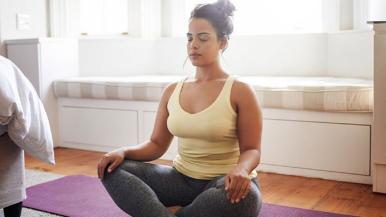As the COVID-19 pandemic continues to evolve, there is one collective certainty: Life has changed — and it changed fast. Now that the preparation, social distancing and shelter in place order have all kicked into action, it is important to remember to reflect on yourself and care for yourself through this.
“This is a big deal; this is a pandemic. There is misinformation in the public, and this sudden crisis is new to us,” says Naomi Parrella, MD, a family medicine provider at Rush. “It is OK to recognize the feelings this new reality arouses. But after you’ve done that, it’s also OK to figure out what we need to do for ourselves and our loved ones to continue to stay connected and live a meaningful life. It helps to keep in mind that this is not forever, and we will get to the other side.”
Parrella offers advice on steps you can take to help get through this time without losing yourself.
Step 1: Talk yourself down
Parrella notes that during a crisis, our first reactions often stem from a survival instinct, which may include a highly emotional state of fear and panic. While these are completely normal reactions, working to shift beyond that mindset will help you move forward.
“When people get emotional and adrenalized, they are not able to function well. They can’t see options — everything is dark, and it is easy to see only doom and gloom,” she says. “But people who do well in crisis management teach themselves to recognize the way they are feeling and then talk themselves out of that state. Once you understand how serious this is, you can set the fear aside and refocus your mind on what you can do next.”
She recommends putting together a script or dialogue that you can say aloud or to yourself, as many times as needed. “You can say, ‘OK, I am feeling upset, and I acknowledge that this is a hard time. I have successfully handled hard times in the past. Now it’s time to put those upset feelings into a box because they no longer serve me. They will be safe there,’ ” says Parrella. “Yes, you can peek into that box periodically, and you can talk yourself out of it by repeating your script and reminding yourself you are a strong human being and you can do this.”
Step 2: Determine your role
So much of the fear and anxiety surrounding the COVID-19 crisis stems from the unknown and uncertainty of how this will all play out. Parrella suggests focusing on what you can control.
“If we focus only on the unknown, the fear can spiral out of control, and it’s contagious,” says Parrella. “Instead, you can step in, use your script, and focus on what you can control and what you can contribute. Maybe that means staying at home, maybe it means taking care of your family or maybe it means continuing to work at your essential job. We all, as a collective global community, are in this together and have a role in helping.”
Creating or maintaining daily routines or some structure for yourself and others can be very grounding.
Step 3: Nurture yourself
As you learn new ways to structure your days, carve out time to take care of your body and mind. Creating or maintaining daily routines or some structure for yourself and others can be very grounding. Parrella offers these easy ways to work relaxation, movement and mindfulness into your days:
- Deep breathing. Take breaks through the day to expand your chest with a simple deep breathing exercise, which provides a natural relaxation response. Take a deep breath as you reach up with your arms and make a Y shape with them. Then, release your arms, neck and shoulders and take three or more deep belly breaths.
- Walking. As you walk outside, observe your surroundings and listen to music that doesn’t have words, whether it’s jazz, classical or instrumental versions of your favorite songs. Nonverbal music helps your brain get into a different, more serene state.
- Physically activating your body. Working up a sweat with cardio exercises can help burn off the stress you’re feeling. Go for a run or walk, try an on-demand exercise class or use an app that offers fun home workouts.
- Meditating. Whether you’ve been meditating for years or are brand new to it, now’s a great time to establish a routine to practice it. There are a variety of ways to meditate, and evidence demonstrates that meditation can effectively reduce stress and improve overall wellness. Try a free guided meditation app to get started.
Step 4: Work on sleep
In times of crisis, your sleep can be one of the parts of life that gets disrupted. While you may have been able to manage the worry and uncertainty during your day, the silence and darkness of bedtime can often open the floodgates.
Parrella suggests going back to that box holding your worries.
“Practice getting really good at visualizing that box or file cabinet where you are putting your concerns, worries and fears,” she says. “Visualize that box in your mind, organize it if you want to and make sure everything gets in there — then set it aside. Your subconscious mind is pretty powerful, and it will take care of things while you are sleeping. Once you set it aside and let your subconscious organize your thoughts, you can allow yourself to relax.”
To further help you relax at the end of the day, Parrella recommends progressive relaxation as you lie in bed. “Progressive relaxation works best when you take slow deep breaths in and out, pausing for a moment with each breath to decompress, working your way gently from the head and face to the neck and shoulders down to your feet,” she says. This allows your body to relax and move into sleep.
“We take care of ourselves and we take care of each other,” Parrella concludes. “When we are facing stressful times, we may need to be more intentional about going back to the tools that work to de-stress us.”




